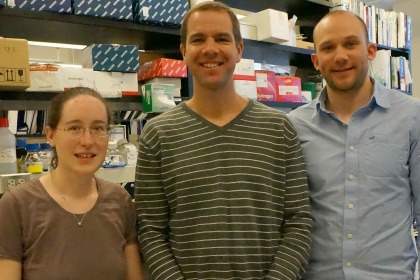A team of University of Vermont researchers has pinpointed a unique self-controlling characteristic of an arenavirus that offers hope of a possible vaccine for now-untreatable infections.

UVM researchers (from left) Emily Bruce, Ph.D.; Jason Botten, Ph.D., assistant professor of medicine and immunobiology; and Christopher Ziegler (Photo: COM Design & Photography)
Discovery of protein alteration could lead to vaccine for arenaviruses
A team of University of Vermont researchers has pinpointed a unique self-controlling characteristic of an arenavirus that offers hope of a possible vaccine for now-untreatable infections.
Arenaviruses reside in rodents, but do not usually damage their health. People, however, are not needed by the virus, so become accidental hosts and can get very sick from some arenaviruses, such as Junin and Lassa.
“The family of viruses is full of really nasty bugs that typically cause hemorrhagic fever syndromes,” says Jason Botten, Ph.D., UVM assistant professor of medicine and an expert in arenaviruses and hantaviruses. Illness in humans is often fatal, and there are no current therapies nor vaccines approved by the federal Food and Drug Administration to protect against these infections.
In their study, published online today in the journal PLoS Pathogens, Botten and his UVM College of Medicine colleagues stumbled upon a much more significant discovery than they expected. Led by graduate student Christopher Ziegler and postdoctoral fellow Emily Bruce, Ph.D., they set out to examine lymphocytic choriomeningitis virus (LCMV) and the way it limits its own replication, so that it doesn’t overrun its host’s body.
In mice and rats, arenaviruses know how to “behave,” Botten explains, “or they don’t get to stay.” The virus has incentive to not only avoid killing its host but also help the host survive – letting the virus thrive and spread. Mothers typically transmit it to their babies.
“Wherever you find mice, you will find arenaviruses and hantaviruses,” Botten says. “Some may cause disease and some may not. They’re just all around us.”
LCMV isn’t particularly dangerous to healthy humans, but it can cause serious disease and death in those with compromised immune systems. Similar to Zika virus, LCMV can infect an adult with barely noticeable symptoms, yet lead to a variety of birth defects in babies of infected mothers. However, it is in a different viral family than Zika, which has received international attention since a recent outbreak in South America.
LCMV spreads by infiltrating a host’s cell and “hijacking” some of the cell’s machinery to make more building blocks of itself and then assemble them into new virus particles. In the final step of the lifecycle, the virus pushes out – or “buds” – through the cell membrane to be released into the blood so it can be transmitted to other cells in the host. In this way, it creates an army of new particles capable of infecting other cells.
Along with new infectious particles, it makes many more faulty ones, or “defective interfering particles.” When they enter a cell, defective interfering particles block any infectious particles that may have also tried to infect that same cell, thus preventing the infection from reproducing to the point of harming the host. In short, the virus makes large numbers of defective interfering particles to prevent itself from setting up productive infections in all the cells of the host. Almost like being on a diet, the virus prevents itself from overindulging because to do so would hurt its rodent host and ultimately the virus’ ability to survive in nature.
In their study, Botten’s team started out looking at a viral protein that drives the virus budding process. They discovered that this protein, called Z, was modified by the addition of a phosphate in a unique region of the protein called a “late domain.” Their original goal was to determine how the addition of a phosphate to this late domain – also known as phosphorylation – might help the virus complete the final step of the budding process, whereby the newly forming virus is literally “cut off” from the cell and ultimately released to go on and infect new cells. In the lab, Ziegler created viruses that couldn’t be phosphorylated to test what would happen.
The nonphosphorylatable virus continued to make just as many infectious particles, but the defective interfering (DI) particles vanished. The UVM researchers inadvertently had found the genetic element that drives DI production. This finding was exciting, because it was the first time a virus had been shown to have a separate pathway devoted solely to the formation of DI particles.
“The key is, sometimes you need to look outside of what you were originally trying to find out, because that’s where the cool things happen,” Ziegler says.
Now, researchers can genetically alter a virus so it doesn’t make DI particles, which is a first for the field. They can inject the altered virus into a mouse to see whether, lacking that regulatory mechanism, it will spread uncontrollably and either kill the animal or reduce its fitness. This is first time the presumed role of DI particles can be formally tested in the animals that carry the virus in nature.
And, they could use the same findings to engineer a vaccine by making a virus that would naturally produce much larger quantities of DI particles following infection. This new virus would actually be attenuated – or weaker- because it would make so many DI particles that it could not spread efficiently in the host.
“It just can’t grow as well as it normally does,” Botten says. “While the virus is able to grow in you, your body has made a full immune response to it, and it will kill it.” Botten and his team have applied for a provisional patent to develop this idea.
Live attenuated viruses have historically made some of the best vaccines. A number of the world’s most malicious pathogens – Ebola, Marburg virus, and even the flu – create defective interfering particles that can presumably control their spread in the host.